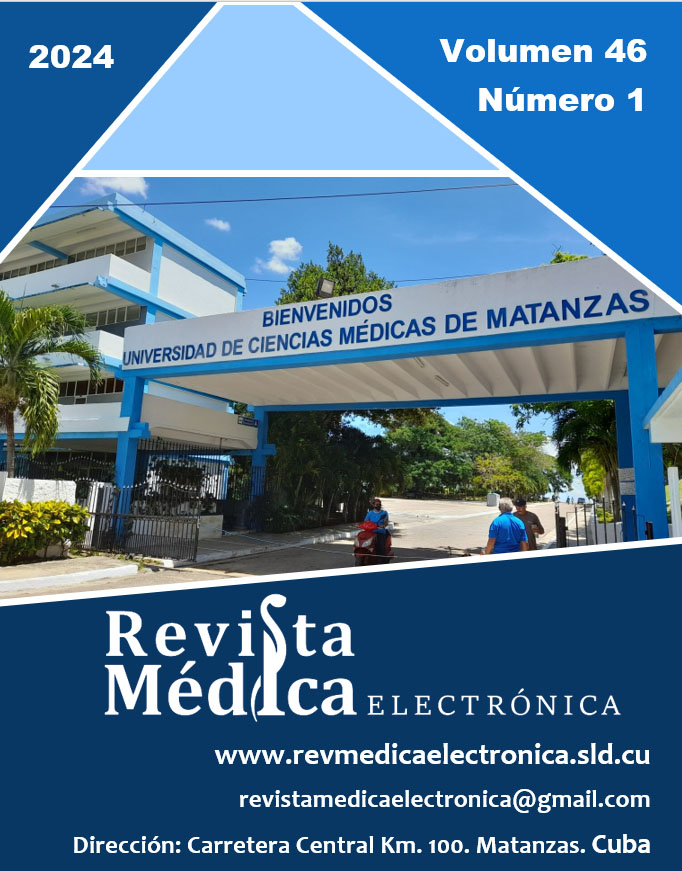Risk factors for cervical cancer in patients treated in a doctor’s office
Keywords:
cervical cancer, risk factors, preventionAbstract
Introduction: Cervical cancer is a serious health problem that can be prevented with early diagnoses and the active participation of women and health professionals.
Objective: To determine the association of risk factors and the onset of cervical cancer in women from Doctor’s office #7 of the Teaching Polyclinic Julio Castillo Alvarez area, in Chambas, Ciego de Avila.
Materials and methods: A retrospective, analytical study was carried out with 18 women aged between 25 and 60 years, with previous diagnosis of cervical cancer, and belonging to the Doctor’s Office # 7, who were treated at the Provincial General Teaching Hospital Roberto Rodríguez, in Morón.
Results: Only 13% of the participants mentioned premature gestations and 37.0 reported vaginal infection. Teenage pregnancy was the most common factor, with 55.6% of women affected. Most of women (92.6%) had taken contraceptives.
Conclusions: The risk factors identified include the first intercourse before the age of 15 and smoking, present in a clear minority. Pregnancy in adolescence and ingestion of oral contraceptives were the most mentioned.Downloads
References
2. Sánchez-Ledesma R, Fernández-Martínez LC, Rodríguez-Gómez MR, et al. Factores de riesgo del cáncer cérvico-uterino en San Juan y Martínez, 2020. Rev Ciencias Médicas [Internet]. 2021 [citado 17/01/2024];25(6):e5287. Disponible en: http://scielo.sld.cu/scielo.php?script=sci_arttext&pid=S1561-31942021000600010&lng=es
3. Bravo Hernández N, Terry Jordán Y, del Prado Osoria A, et al. Una vía para favorecer cambios de actitud dirigidos a prevenir el cáncer cervicouterino. Rev Inf Cient [Internet]. 2019 [citado 26/10/2020];98(5):608-18. Disponible en: http://scielo.sld.cu/scielo.php?script=sci_arttext&pid=S1028-99332019000500608&lng=es
4. Villafuerte Reinante J, Hernández Guerra Y, Ayala Reina ZE, et al. Aspectos bioquímicos y factores de riesgo asociados con el cáncer cérvico uterino. Finlay [Internet]. 2019 [citado 03/09/2020];9(2):138-46. Disponible en: http://www.revfinlay.sld.cu/index.php/finlay/article/view/635
5. Díaz Mc Nair AG, Cedeño Arroyo M, González Heredia E, et al. Acciones educativas para la prevención del cáncer cervicouterino en la adolescencia. Medisan [Internet]. 2011 [citado 12/02/2024];15(2):209-14. Disponible en: http://scielo.sld.cu/scielo.php?script=sci_arttext&pid=S1029-30192011000200010&lng=es
6. Domínguez Bauta SR, Trujillo Perdomo T, Aguilar Fabré K, et al. Infección por el virus del papiloma humano en adolescentes y adultas jóvenes. Rev Cubana Obstet y Ginecol [Internet]. 2018 [citado 20/03/2020];44(1):[aprox. 13 pantallas]. Disponible en: https://www.medigraphic.com/pdfs/revcubobsgin/cog-2018/cog181q.pdf
7. Dirección de Registros Médicos y Estadísticas de Salud. Anuario estadístico de salud 2022 [Internet]. La Habana: Ministerio de Salud Pública de Cuba; 2023 [citado 17/01/2024]. Disponible en https://files.sld.cu/editorhome/files/2023/09/Anuario-Estadistico-de-Salud-2022-Ed-2023.pdf
8. Montero Lora Y, Ramón Jimenez R, Valverde Ramón C, et al. Principales factores de riesgo en la aparición del cáncer cervicouterino. Medisan [Internet]. 2018 [citado 26/10/2020];22(5):531-7. Disponible en: http://scielo.sld.cu/scielo.php?script=sci_arttext&pid=S1029-30192018000500010
9. Alonso Triana L, Soto Ramírez E, Ugalde Pérez M, et al. Diseño de intervención educativa para la prevención del cáncer cérvico uterino en estudiantes universitarios. Rev Méd Electrón [Internet]. 2019 [citado 26/10/2020];41(4):914-27. Disponible en: http://www.revmedicaelectronica.sld.cu/index.php/rme/article/view/3283
10. Villanueva González RY, Ruvalcaba Ledezma JC. La vida sexual insegura como riesgo para cáncer cervicouterino en mujeres con displasia cervical. J negat no posit results. 2019;4(5):537-50. DOI: 10.19230/jonnpr.2834.
11. González Bango MA, Blanco Pereira ME, Ramos Castro G, et al. Educación sobre cáncer cervicouterino en la adolescencia. Rev Méd Electrón [Internet]. 2018 [citado 26/10/2020];40(4). Disponible en: http://www.revmedicaelectronica.sld.cu/index.php/rme/article/view/2668
12. Edith Pamela EC. Factores de riesgo asociados a la displasia de cérvix en pacientes atendidas en la unidad de displasia del hospital San José en el año 2016 [tesis en Internet]. Lima: Universidad Ricardo Palma; 2018 [citado 13/02/2024]. Disponible en: https://repositorio.urp.edu.pe/handle/20.500.14138/1159?show=full
13. Flores-García A, Ruiz-Bernés S, Aguiar-García P, et al. Micronúcleos y anormalidades nucleares en células de la mucosa bucal de mujeres mexicanas con factores de riesgo para cáncer cervicouterino: estudio piloto. Residente [Internet]. 2018 [citado 03/09/2019];13(2):56-61. Disponible en: https://www.medigraphic.com/cgi-bin/new/resumen.cgi?IDARTICULO=81714
14. Vásquez-Awad D, Ospino AM. Anticonceptivos orales combinados. Ginecol Obstet Mex [Internet]. 2020 [citado 05/05/2021];88(Supl 1):S13-31. Disponible en: https://ginecologiayobstetricia.org.mx/articulo/anticonceptivos-orales-combinados
15. Lucía Salazar E, Luis González J, Olmos A, et al. Influencia del uso de anticonceptivos orales como factores de riesgo para infección por virus del papiloma humano y neoplasia intraepitelial cervical. Ginecol Obstet Mex [Internet]. 2005 [citado 05/05/2021];73:83-9. Disponible en: https://www.medigraphic.com/pdfs/ginobsmex/gom-2005/gom052e.pdf
16. Tafurt-Cardona Y, Acosta-Astaiza CP, Sierra-Torres CH. Prevalencia de citología anormal e inflamación y su asociación con factores de riesgo para neoplasias del cuello uterino en el Cauca, Colombia. Rev Salud Pública [Internet]. 2012 [citado 05/05/2021];14(1):53-66. Disponible en: http://www.scielo.org.co/scielo.php?script=sci_abstract&pid=S0124-00642012000100005&lng=en&nrm=iso&tlng=es
17. Becker TM, Wheeler CM, McGough NS, et al. Cigarette smoking and other risk factors for cervical dysplasia in southwestern Hispanic and non-Hispanic white women. Cancer Epidemiol Biomarkers Prev [Internet]. 1994 [citado 05/05/2021];3(2):113-9. Disponible en: https://pubmed.ncbi.nlm.nih.gov/8049632/
Downloads
Published
How to Cite
Issue
Section
License
All content published in this journal is Open Access, distributed under the terms of the CC BY-NC 4.0 License.
It allows:
- Copy and redistribute published material in any medium or format.
- Adapt the content.
This will be done under the following terms:
- Attribute the authors' credits and indicate whether changes were made, in which case it must be in a reasonable way.
- Non-commercial use.
- Recognize the journal where it is published.
The copyrights of each article are maintained, without restrictions.






